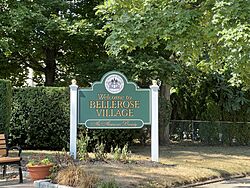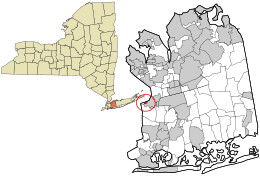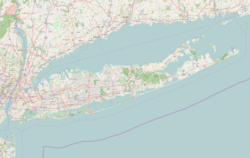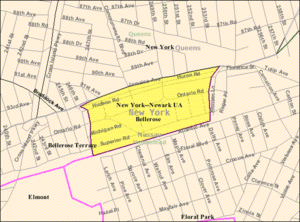Bellerose, New York facts for kids
Quick facts for kids
Bellerose, New York
|
|
|---|---|
| Incorporated Village of Bellerose | |

A village welcome sign at the Bellerose station in August 2022.
|
|
| Motto(s):
"An American Beauty"
|
|

Location in Nassau County and the state of New York
|
|
| Country | |
| State | |
| County | Nassau |
| Town | Hempstead |
| Incorporated | 1924 |
| Area | |
| • Total | 0.13 sq mi (0.33 km2) |
| • Land | 0.13 sq mi (0.33 km2) |
| • Water | 0.00 sq mi (0.00 km2) |
| Elevation | 85 ft (26 m) |
| Population
(2020)
|
|
| • Total | 1,173 |
| • Density | 9,309.52/sq mi (3,605.08/km2) |
| Time zone | UTC-5 (Eastern (EST)) |
| • Summer (DST) | UTC-4 (EDT) |
| Zip Code |
11001
|
| Area codes | 516, 363 |
| FIPS code | 36-05639 |
| GNIS feature ID | 0943608 |
Bellerose (pronounced bell-rohz) is a small village located in Nassau County, New York. It's found on Long Island, a large island near New York City. In 2020, about 1,173 people lived there. Bellerose is part of the Town of Hempstead.
Contents
History of Bellerose Village
How Bellerose Was Founded
The village of Bellerose was started by a woman named Helen Marsh. She lived in Williamsburg, Brooklyn. In 1907, Helen Marsh had a big idea. She wanted to build a perfect community. She bought about 77 acres of land. This land was once used for growing gladiola flowers in Floral Park.
Building the First Homes
The very first house in Bellerose was finished in 1910. Helen Marsh watched over the building work herself. She also convinced the Long Island Rail Road to put a train station in her new village. She decided to name this station Bellerose.
The Name "Bellerose"
Some people thought Helen Marsh named the village after a nearby Rose farm and her daughter, Belle. But Helen Marsh said she just liked the sound of the name. She thought "Bellerose" sounded nice. In 1917, the people living in the homes voted to make the name Bellerose official.
Becoming an Official Village
In 1924, Bellerose became an official incorporated village. This meant it could make its own rules and manage its own local affairs. This is called "home rule."
Historic Buildings in Bellerose
The main buildings for the village government are very special. The Bellerose Village Hall, Fire House, and Police Booth are all together. This group of buildings is known as the Bellerose Village Municipal Complex. These buildings are listed on the National Register of Historic Places. This means they are important historical sites for both the state and the country.
Geography of Bellerose
Where is Bellerose Located?
Bellerose is a small village. It covers about 0.12 square miles (0.33 square kilometers) of land. There is no water within the village boundaries.
Neighboring Areas
Bellerose shares its borders with a few other places. To the north, it touches Queens, which is a borough of New York City. To the west, it borders Bellerose Terrace. To the south, it is next to Floral Park.
Population of Bellerose
How Many People Live Here?
The number of people living in Bellerose has changed over the years.
| Historical population | |||
|---|---|---|---|
| Census | Pop. | %± | |
| 1930 | 1,202 | — | |
| 1940 | 1,317 | 9.6% | |
| 1950 | 1,134 | −13.9% | |
| 1960 | 1,083 | −4.5% | |
| 1970 | 1,136 | 4.9% | |
| 1980 | 1,187 | 4.5% | |
| 1990 | 1,101 | −7.2% | |
| 2000 | 1,173 | 6.5% | |
| 2010 | 1,193 | 1.7% | |
| 2020 | 1,173 | −1.7% | |
| U.S. Decennial Census 2010 2020 |
|||
In 2020, the village had a population of 1,173 people. This was a small decrease from 2010, when 1,193 people lived there.
Diversity in Bellerose
Bellerose is home to people from many different backgrounds. Most residents are White. However, there are also people who identify as Black or African American, Asian, and those of mixed races. A growing number of residents are of Hispanic or Latino heritage.
Education in Bellerose
Local School Districts
Students in Bellerose attend schools in two different districts. Younger students go to schools in the Floral Park-Bellerose Union Free School District. Older students, usually in high school, attend schools in the Sewanhaka Central High School District.
Notable People from Bellerose
Some interesting people have lived in Bellerose:
- Joanne Persico is a well-known volleyball coach.
- John P. Shanley (1915-1985) was a journalist. He wrote a lot about radio, television, and plays for The New York Times.
- Nick Wall (1906-1983) was a jockey, a person who rides horses in races.
See also
 In Spanish: Bellerose (Nueva York) para niños
In Spanish: Bellerose (Nueva York) para niños




